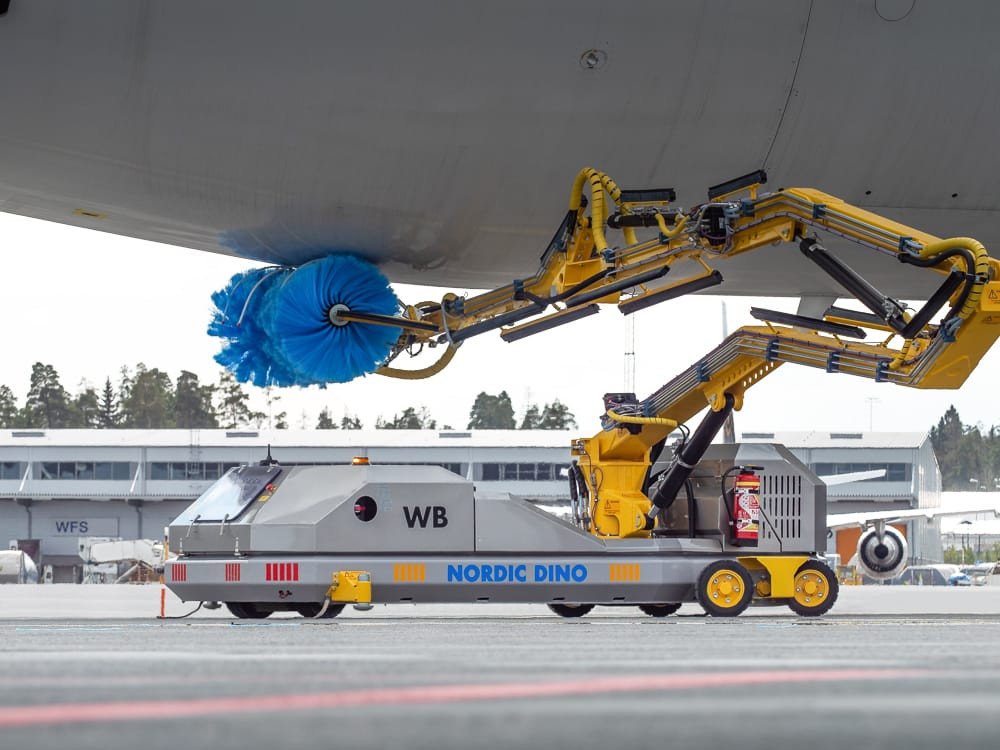
Every year the aviation industry develops new solutions to improve the efficiency of ground handling operations and increase workers’ safety. More and more companies adopt improved ground support equipment (GSE) that can benefit from both the advancement of operational performance and help to avoid accidents at work. A good example of such a useful GSE is a aircraft cleaning robots. Modern cleaning systems can improve this productivity and protect workers from significant risks associated with manual cleaning operations. Veronika Andranovaite, CCO from Nordic Dino Robotics AB explains how mechanical cleaning systems can convert daily flights by setting workers’ safety priorities and setting new industry standards.
Although manually cleaning the external aircraft is standard for flying, it represents many risks. Exposure to dangerous chemicals, physical pressure and work at dangerous altitudes – all of these factors pose potential risks for employees. Also, the plane cleaning manually includes frequent movements, lifting heavy equipment, bending and frequent expansion. Over time, this can lead to fatigue and pressure among maintenance workers. To address this issue, land handling companies can build automatic cleaning systems such as Nordic Dino, which helps reduce human employment.
“These advanced machines are designed to deal with the most demanding aspects of cleaning, and access to high and low surfaces. The shift towards automatic aircraft cleaning systems greatly reduces the risk of industry workers, and it enhances efficiency, which reduces the costs of ground handling.”
Another problem is to use strong cleaning factors – chemicals that help remove dirt, dirt and environmental pollutants that accumulate on the outside of the plane. But when workers are often exposed to them, these chemicals can form serious health risks. Veronika Andranovaite warns that direct contact with harsh materials may lead to respiratory problems, skin irritation, and other health concerns in the long run.
“Automatic systems provide a safer alternative by automating the application of cleaning factors. It guarantees an accurate and equivalent distribution of chemicals and reduces human interaction with possible harmful substances. Moreover, these modern systems help improve the use of cleaning materials, and at the same time, reduces environmental waste, and water consumption,” CCO comments for the Nordic Dino AB.
According to the International Air Transport Association (IATA), the most frequent injuries between ground handling employees include vouchers, trips, fall, or exposed to things and injuries related to lift, pregnancy, payment, or withdrawal. Falling from the heights, although less frequently, are among the strongest.
Working at high altitudes is a serious threat facing workers while manually cleaning the external plane. To clean up the upper surfaces of the plane, employees often use scaffolding, elevators or platforms, which makes the risk of falling and severe injuries. Moreover, the specific weather conditions, such as strong winds or rain, can increase the risk of harming yourself.
“Advanced aircraft cleaning robots are equipped to move independently or use the process or by using the process. This allows workers to remain safe on the ground. These days, modern robots such as the north Dino can prevent the workplace accidents and enhance safety standards,” Andrianovaya notes.
With the continued development of the aviation industry, automatic cleaning systems prove that they are invaluable assets for ground handling processes. Mechanism systems help airlines to maintain the virgin appearance and operational efficiency of aircraft. Besides, high -tech robots protect health and enhance the safety of those who keep plane in the highest condition.